Chris Baty's Blog, page 50
October 12, 2020
3 Ways to Build a Supportive Creative Community

Do you have a community of fellow writers who can share the ups and downs of the creative process with you? Today, NaNoWriMo participant Mary Frances Gualandri is here to share some of the steps she’s taken to build her creative community:
Perhaps one of the most rewarding benefits of partaking in seven years of NaNoWriMo has been the connections formulated with fellow writers. Within many social circles, discussing the process of crafting a novel, short story, screenplay, or any other work of writing can temporarily allow the writer that moment of true elation and their passion to emerge. While those who do not create can often share in the excitement and wonderment of creation, it is entirely different to speak to those who have experienced the joy, frustration, and indescribable fulfillment that emits from developing and honing a work that at one time was simply a small spark of idea. Few understand how something as simple as a fleeting moment in a dream or inspiration that struck on a morning commute can be the basis of an elaborate storyline.
Over the years, I have connected with many writers from different parts of the United States as well as some around the world. This year, which has forced many to look to unconventional sources for human connection in the midst of a global pandemic, oddly proved to be when I’ve cultivated the writing community I’ve searched for. Outside of my best friend and a few other isolated writers I’d met over the years, I’d never truly found that sense of community.
With this year’s update to the format of Camp NaNoWriMo and the establishment of year-round writing groups, what I found is an incredible circle of writers from a remarkable array of backgrounds and parts of the world. Throughout the two Camps this year, these writers were the people I reached out to with questions, ideas to bounce off and snippets to share. To say that the first of November cannot arrive soon enough would be a massive understatement.
2. Enlist Non-Writers.Beyond the scope of NaNo’s groups and forums, however, what I’ve also discovered about having a writing community is that it does not have to consist of only writers, and in fact, it’s better if it is not entirely comprised of them. One of my best friends is a creative multi-threat; she writes music and stories as well as shoots incredible photographs and crafts beautiful art. Several of my close friends are intense consumers of books, film, and music, perfect for discussing storylines and character appeal, especially because they are willing to make the deep dive into whatever project is in the works. Another friend is an actor who spends many hours transforming into a character, creating another space for in-depth conversations about character development. Other friends and colleagues have remarkably biting wit or quite simply a striking personality that just might provide unexpected insight or perhaps even inspiration.
3. Build Connections.Perhaps the key to building a writing community is to surround yourself with not only a multitude of creatives, but of people in general. Connect with the artists in your friend group and discuss their process with them. Discuss the creative process with a local musician or songwriter. Chat with a coworker about what they loved about the latest novel they read. It’s all about connection. Contrary to popular belief, writing is not a solo effort, and with technology, it is now easier than ever to reach out to other writers, creators, and even just individuals from a different background or part of the world. Ultimately, these connections will enhance the often-grueling writing process, mold characters and storylines to avoid cliché, and craft the story you were “born to write.”

Mary Frances Gualandri is a writer, poet, and blogger. She is the creator of
The
Hopeful Romantic
, a blog dedicated to the appreciation and analysis of love in pop culture. At this time, she is working on several projects in a wide multitude of genres while continuing to pen posts for her blog. When she is not writing, Mary Fran enjoys watching sappy rom-coms, listening to music, and spending time with family and friends. You can find her on
Facebook
, Twitter @MaryFGualandri, and Instagram @maryfgualandriauthor.
October 9, 2020
3 Tools for Your Worldbuilder’s Toolkit

Are you new to worldbuilding and looking for some tools that can help you craft the perfect setting for your novel? NaNoWriMo Participant Jaluna Rolik shares some of her favorites with us!
Have you started worldbuilding yet, or are you planning to make it up as you go? Even pantsers should have some idea of the world they’re going to work in before they start!
Worldbuilding is a long, sometimes tedious, process, but it’s well worth the work. Even if your novel is set in a world that looks very similar to the one we live in, you’re probably going to want to do some worldbuilding to prepare. I generally work in worlds of my own creation. Today, I’d like to share some reasons worldbuilding can be useful, things you can include that might help you, and some (free!) tools that can be a great help in keeping it all together:
1. Keep track of your world’s calendar.There are lots of reasons to worldbuild. Getting a feel for the cultures and calendar(s) of your world gives you more scenes you can include, ranging from religious festivals and rites to cultural anomalies or troubles that come from the social construct of your system. If you’ve got a lot of different kinds of magic, making a list of spells and methods to use magic can be a great worldbuilding exercise to keep you organized.
A great program for this is Google Sheets. I use it all the time to make calendars! Calendar-making is tedious and tough, but in a fantasy world that probably won’t match up with Earth, making a calendar for yourself so you can see when a character’s birthday is and when holidays come up can help you with events in your story based on the season. This may seem small, but it will help give your readers a more immersive experience.2. Visualization is your friend.I have a condition called aphantasia—which means that I have no ability to visualize things in my head. As such, visual constructs in front of me, such as maps, calendars, etc., are extremely vital for me to keep track of things without getting a headache. Thankfully, there are lots of resources out there to help people like me to worldbuild! I use plenty of different programs to help guide my worldbuilding. Here are some of the tools I use when building up my setting:
Notion is perfect free program for writers. You can either find a template specifically for worldbuilding, or you can make your own with all sorts of features, like lists, images, and even checklists if you think that would help you!3. Keep your planning notes in order.Worldbuilding can include almost anything—planning out the species of animals and plants, making languages for the different cultures of the world, time-lining the history of the world, and even denoting how the world was created. It’s all worldbuilding, and it all can have a great effect on your story’s potential!
Do you find Wikis really useful, or are you a fan of Microsoft Onenote but want a free option? Try CherryTree! It’s very customizable and it’s a great program to make your own nesting lists, note pages, and then some. I use it a lot, as I have a ton of religions planned out for one world that’s part of a lot of stories. I have the geography basics listed in it, as well, and some plot things, too.So please, if you’re a planner, plantser, or even pantser, don’t skimp on worldbuilding. Plan anything and everything you think will make your world really feel like a reality for yourself and your readers—it’s sure to give a new layer to your story that will surely wow everyone—even yourself!
Jaluna Rolik was born and raised in New Jersey, and still lives there today. Though her life has certainly had some rough patches, she always does her best to find the positive in life’s woes. In her endless free time, she can usually be seen playing video games, writing, or reading manga. She lives with her father, also a writer, who is always helping her through life’s mysterious ways. Folllow her on Twitter!
Top photo by Chris Lawton on Unsplash.
October 8, 2020
3 Edits to Make Your Manuscript More Engaging for Your Readers
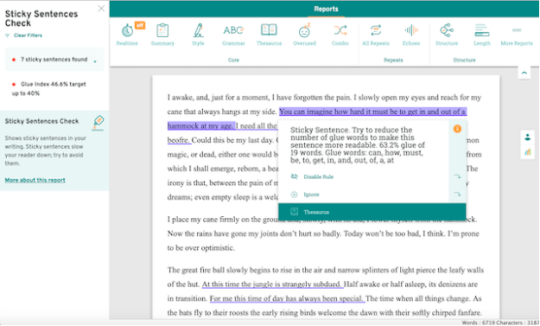
Every year, we’re lucky to have great sponsors for our nonprofit events. Today, ProWritingAid—a top-notch editing software—shares some tips for making your manuscript more engaging for your readers. ProWritingAid is a NaNoWriMo 2020 sponsor.
Your first draft is just that: a draft, which will likely need some significant edits to make it as engaging as possible for your readers.
As a writer, your job isn’t just to create compelling characters or craft a tantalizing plot. You also need to get your meaning across clearly and effectively. If your writing is too complicated or hard to follow, then you’re not doing your job. You might have created the coolest character in the history of the universe—but if what makes them cool is hidden in awkward and confusing sentences, then your reader will never know.
During the editing process, it’s important to hone in on sentence-level edits that can increase the clarity of your work. Let’s take a look at three issues ProWritingAid flags that can make your writing more engaging for your readers:
1. Check Your ReadabilityMany writers, especially new writers, write in a way that is difficult to follow and understand. While it may sound counter-intuitive, bestsellers are often simple and easy to read.
In the United States, the average adult prefers fiction written at a 7th–8th grade reading level (12–14 years old). Making your writing easier to read doesn’t mean that you have to dumb down your ideas—you can still have complex and entertaining stories told with simple, clear language. For instance, Hemingway wrote at a grade-school reading level.
Clear words and sentence structures make your ideas shine. Every time your reader has to stop because they didn’t follow a long, complex sentence, they will have come out of your story for a moment. That pause makes your writing less engaging.
Try ProWritingAid’s Readability Report, which flags the paragraphs and sentences in your writing that might be unclear for your readers. That way, you can edit the sentences to make them more accessible.
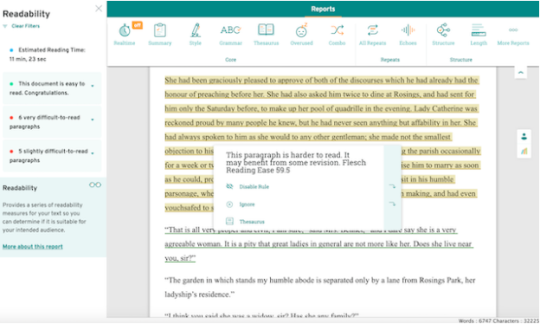 2. Focus on Working Words
2. Focus on Working WordsHere at ProWritingAid, we say that every sentence has two types of words: working words and glue words.
Working words are usually nouns and verbs and they contain the sentence’s most essential information. By contrast, glue words are those that make the essential pieces of the sentence stick together. They are words that don’t carry much meaning in and of themselves, yet are necessary to create a coherent sentence.
Let’s take a look at this sentence:
Jenna hurled the basketball from half-court and watched it soar.
The italicized words are the working words. If you changed any of those words, the meaning of the sentence would shift. The rest of the words are glue words: they don’t have much impact on the sentence itself. In the above sentence, there are more working words than glue words and its meaning is clear.
If your sentences have too many glue words, they’re likely overly wordy and difficult to follow. The Sticky Sentences Report helps you identify the percentage of glue words in your sentences.

We recommend aiming for an average of less than 40% glue words throughout your manuscript. If a sentence is flagged as sticky, see if you can rewrite it in a way that is clear and concise.
For example:
Original: I went to the beach and relaxed there.
(50% glue words)
Rewrite: I relaxed on the beach.
(40% glue words)
3. Minimize Your Use of Dialogue TagsDialogue tags are the words you use to help readers understand who is speaking, especially when two or more characters are talking. The two most commonly used ones are “said” and “asked.”
You only need dialogue tags when you need to identify who’s talking. If the speaker is obvious to the reader, then skip the dialogue tags—they’ll just get in the way of your reader’s experience.
Non-standard dialogue tags like “shouted,” “whispered,” “repeated,” and “ventured” are also signs of poor writing because they tell emotions, rather than letting the dialogue and actions of your characters show their emotions.
ProWritingAid’s Dialogue Tags Check lets you instantly see how many dialogue tags you’ve used in your writing, as well as what they are. Make sure you haven’t overused dialogue tags or included too many non-standard tags that “tell” emotions.
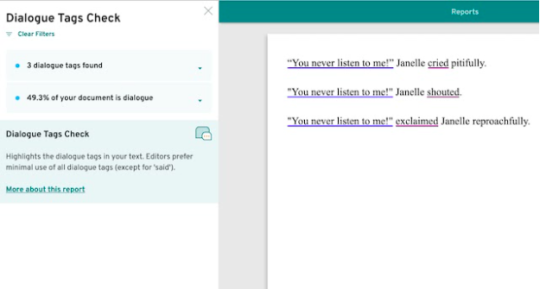
Final Thoughts
Bestselling books don’t just have compelling characters and an engaging plot: they also have writing that is reader-focused and easy to understand.
ProWritingAid’s 20 reports highlight elements like repetitiveness, vague wording, over-dependence on adverbs, passive voice, over-complicated sentence constructions, and so much more. Our unique combination of suggestions, articles, videos, and quizzes help you master new concepts and make writing fun and interactive.
As a NaNoWriMo participant, you can get $100 off a ProWritingAid lifetime license here.

Hayley Milliman is thrilled to be
ProWritingAid
’s Content Lead, as it gives her an excuse to think deeply about words every single day. Prior to joining ProWritingAid, Hayley spent a number of years as an elementary school teacher, which was a crash course in learning how to entertain an indifferent audience. These days, she puts her storytelling skills to use writing blog articles and working on her first novel. She is the co-author of the book
Museum Hack’s Guide to History’s Fiercest Females
(which was an Amazon bestseller) and
How to Build Your Author Platform on a Shoestring
.
October 7, 2020
Enjoying Your Setting, Even If It Makes No Sense

Sometimes, you sit down to write your story and all you have is a faint idea of some minute character/item/place you want to include. That’s okay. Find out how NaNo Participant Timothy Wolfe managed to overcome building the world of his novel from scratch:
Generally, from what I’ve observed, worldbuilding tends to fall into two distinct categories. Either the world is designed first and the plot crafted to fit within it, or the inverse happens: where the setting takes on a more utilitarian purpose designed to reinforce the plot, the themes, or the characters. My NaNoWriMo project from last year didn’t really fit into either of these categories.
Instead, it was based on a very specific image that kind of just appeared one day from the depths of my brain. It was a rusted out Route 66-esque gas station next to a lonely stretch of desert highway. And in the background, on the distant horizon, loomed the ruins of some enormous alien city, remnants of some ancient precursor civilization. And that was all I had to go on. No characters to work with. No context for the image. No history. No backstory—basically nothing. I had tried—and failed—before to turn that image into a full length novel and most of them kind of spluttered out and it didn’t seem possible.
But I’m stubborn. And so I kept plugging away at it and I decided I was going to give another shot for NaNoWriMo 2019. So I went about making some basic plans—I borrowed the plot framework from an old novel I’d attempted as a teenager, I hammered out fresh outlines for the first few chapters that I hoped would provide me the momentum that would see me past the finish line, and I came up with a handful of story hooks that could hopefully get me past any writer’s block I was expecting to encounter.
I also decided that, once I started, I wasn’t going to try to justify the setting to myself nor was I going to go out of my way to try and explain why it is the way it is. Why is all this specific brand of Americana just sort of here? What’s up with the alien ruins? I don’t know. The characters don’t know either. And the answers to those questions are going to be put on the back burner.
“The major thing I learned about world-building is that you don’t have to justify your setting, regardless of how ‘out there’ and weird it is.”The results ended up being really surprising. Not only did I successfully finish it, but it was the first time I’ve finished a big project like a novel since high school in 2007. And the new version ended up answering at least some of the questions that obsessed me in previous attempts to tell the story. A lot of the explanations I’d been trying to basically beat out of it sort of… answered themselves over the course of that month in November.
The major thing I learned about world-building is that you don’t have to justify your setting, regardless of how “out there” and weird it is. And sometimes, if you’re stuck, it’s maybe better to just take a step back and let the setting exist and just be in it, with your characters without trying to brute force-answers out of it.
I plan to rewrite the draft this year and I have a much clearer sense of my plot, my characters, and even the world. I’m not going to pretend I still know everything about how it functions and why it is the way it is, but I also know I’m not going to try to force answers that it doesn’t want to give. I’m just going to enjoy being in the moment again and enjoying writing out this really off-kilter aesthetic.
Tim Wolfe is an aspiring fantasy novelist whose main dream is to one day write fantasy novels for a living. He has finished three novels, two of which were all the way back in high school and one of which was as recently as last year, for NaNoWriMo 2019. You can find him on Twitter or on the NaNoWriMo website as Orions_Gift.

Top image: “Giant Route 66 Neon Sign” by Chuck Coker is licensed under Creative Commons on Flickr.
October 5, 2020
Five Mystery and Suspense Tools to Drive Your NaNoWriMo Novel Forward
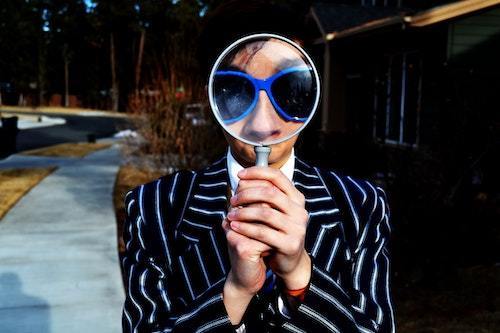
Every year, we’re lucky to have great sponsors for our nonprofit events. Today, Sisters in Crime—a community platform for mystery, thriller, and crime writers—shares some tips for writing suspenseful storylines (even for non-mystery novels!). Sisters in Crime is a NaNoWriMo 2020 sponsor.
In the crime fiction genre—including suspense novels, mysteries, and thrillers—there’s nothing better than the reader review that says “I stayed up all night to get to the end.” The propellant writers construct to push readers through to the final page is known as “narrative drive,” something our genre relies on to get readers hooked and turning pages. But it’s not only genre fiction that needs to suspend readers’ attention for the length of a story. Any story needs to catch fire in the reader’s mind to be successful.
And anyone writing 50K in 30 days needs a few ideas for generating tension in their story—without slowing down. As you #NaNoPrep this year, consider these five tools from Sisters in Crime, the international, inclusive organization for writers and readers of crime fiction, mysteries, thrillers, and suspense.
What’s in the mystery and suspense writer’s tool box for you?1. A great sleuth.In our genre, the lead character is, ideally, curious. If you can write a character who engages with their world, readers get to engage, too, and you have done half the work of enticing readers to finish your novel. Make your protagonist want something, make them desire and fear, make them real. They don’t have to be “likable,” but they need to be interesting.
2. A pile of problems.Where’s the trouble in your story? If there are no obstacles to your character’s desires, no chance to face their fears, there’s no tension and no change ahead for them. Also populate your story with secondary characters who represent trouble and strife. Let sparks fly. Let terrible things threaten and then happen.
3. A ticking clock.Where’s the time pressure in your story? In a thriller, the characters race against a terrible eventuality, but your characters may need to figure something out about themselves by the time their prom date arrives to pick them up. Find an event on the horizon of your story that creates a countdown for your character to succeed—or fail—and realize change and growth.
4. A slew of questions.In mysteries and crime fiction, we write to create questions in the reader’s mind—the big question often “Who committed this crime?” The trick: don’t answer them right away. That’s great news for NaNoWriMo, isn’t it? Hint at backstory you don’t yet know. Drop in clues to relationships and connections you’ll figure out later.
5. Suspects and evidence.Or in layman’s terms: people and stuff. Make your word count by populating your story with characters and all their oddities and proclivities. The great news for WriMos is that you aren’t required to decide yet what role any of this plays in your outline or final story. Professional writers rely on revision, and so will you.
Best of luck, Wrimos!
Learn more about how to use mystery and suspense tools—even, perhaps, for a mystery or suspense story!—at Sisters in Crime’s live webinar “Slay NaNoWriMo: Two Converts Share Their Secrets” with Rachael Herron and Gigi Pandian (Sisters in Crime members and veteran Wrimos) on Wednesday, October 7, 8 pm Eastern/5 pm Pacific. It’s free and open to the public as a live event, archived for SinC members only afterward. Also, don’t miss our sponsor offer for a 20 percent discount to become a member of Sisters in Crime, joining our #SinC50K NaNoWriMo Challenge, and finding support in our #SinC50K Facebook Group!
Top photo by Marten Newhall on Unsplash.
October 2, 2020
Building Naturally Diverse Characters
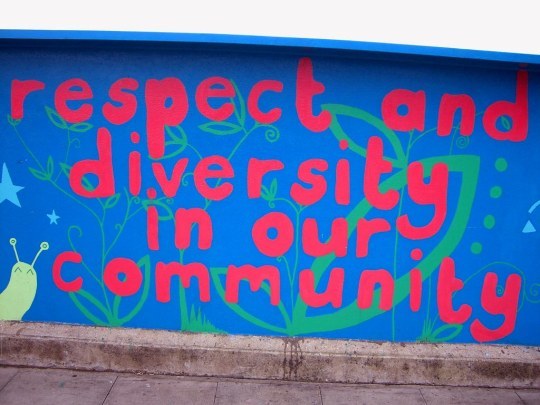
How do you know that you’re writing diverse characters, not only for the sake of having numbers but because they add to your plot? We asked NaNo Participant K. Lawrence her opinion.
Characters deserve to be well-rounded, multi-faceted individuals. This is true no matter whether your character has a disability or what sexuality, gender, race, or age your character is. This post focuses on character creation as a whole because, when done right, diversity should naturally find its way into your writing.
Writing Character Bios:Character bios are a great way to get a feel for who your characters are. Bios can list whatever you like, from physical traits to things like drives and desires. Your character does not exist in isolation of course, and just like real life their upbringing and location can shape their personality. Your initial idea for your story will also play a part in molding each character as you will have certain things your character needs to do and they will require certain traits to see them through.
So, how does this feed into a diverse cast of characters? Giving each character a bio forces you to think of more than one aspect of their character and will pull you away from the major pitfalls of writing characters who are not like you, like falling into stereotypes or one-dimensional, one issue characters. Even if the plot focuses on your character coming out or a struggle faced by a specific group please remember that your characters are more than avatars created to discuss those issues.
Treating Your Characters With Respect:Research anything you are unsure of. Ask questions. But remember the experience of one person who happens to be the same race, sexuality, or gender as your character does not equate to the experiences of all people in that group. If you do write something that gets a negative reaction from the group the character belongs to then listen to what they are saying, understand why they are saying it. There is no shame in making a mistake with anything in your writing as long as you learn from it.
It can be really simple, seemingly harmless things like your villain being the only character who is agender or making any characters with disabilities perfect, overly nice people with no negative traits that may hurt the most. Be mindful of who you are picking for each role in your book and ask yourself why you are making those choices.
Don’t forget that having diverse characters is more than a numbers game. Filling your story with every different kind of person you can think of will not only harm your story and make it unrealistic but could come off as offensive. Characters should have a purpose, whether that is as your main character or the doctor they happen to meet once in your story, and even the bit parts should have a bit of substance behind them.
Writing a diverse cast of characters doesn’t have to be hard. Just be respectful of where your characters come from, remember your research, and stay true to who your main character is and who they would realistically come into contact with based on the location and time period of your story. Though it may seem daunting to write outside what you know, please make the effort to include diverse characters. Your writing will be more realistic and richer for it.

K. Lawrence is a writer, live streamer, and artist from the North East of Scotland and is the author of the novel, The Raven and The Nightingale. She also has short stories published in various erotica and horror anthologies, all of which can be found on Amazon. She lives with her husband, son, and a ginger and white cat called Jerry. When not writing or painting, K.Lawrence enjoys listening to music and meeting friends.You can find her on Twitch, Instagram, Facebook, and Amazon.
Photo licensed through Creative Commons by Davide Taviani.
September 30, 2020
Join Our #InstaWrimo Instagram Challenge in October!

NaNoWriMo is coming up in November, so we want to help you prep for your writing journey and develop your novel idea with our annual month-long #InstaWrimo challenge. We designed a month of photo prompts (both concrete and abstract) to get you thinking about characters, setting, and story. All you need to join in is an Instagram account!
Follow @NaNoWriMo on Instagram.Use the 31 photo prompts listed in the graphic above to start thinking about your novel. We’ll post the full challenge prompt on Instagram, but it will also be available in this post if you need to refer back to it.
These prompts are just suggestions—you can interpret them as literally or as whimsically as you like. You can post a photo for each of the prompts, or choose just a few. You can post one every day, or all at once. There aren’t any strict rules—the most important part is having fun!
Make sure to tag any posts with the #InstaWrimo hashtag so we can find them. We’ll pick photos from the challenge to feature on our own Instagram account throughout the month. Follow the hashtag to see what our awesome community is up to, and to get inspired. You can also tag a friend you think would like to join you in the challenge!
Use your imagination, get creative, and get ready to write! Don’t forget to announce your novel on the NaNoWriMo website when you know what you’ll be writing about!
IMAGE: A graphic of a brick wall with 3 windows featuring a writer with candles and a coffee mug, plants on the windowsill, and pages flying out of a book. It is labeled “It’s NaNo Prep Time! Tag #InstaWrimo for @nanowrimo”, and featuring the following prompts:
September 28, 2020
How (And Why) To Keep Looking for Inspiration in an Uninspired Year
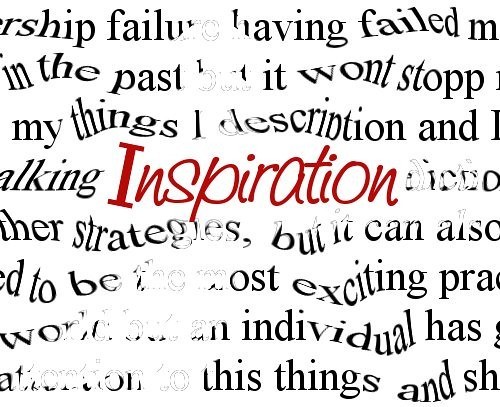
In times like this, finding the desire to write can be hard, and sometimes finding the inspiration to be creative can feel like a Herculean task. Here are 3 ways that NaNo Participant Sabrina Howard assures can help inspire you to write your next adventure.
Scarcity is weighing heavily on people around the world, from lack of clean water, food, and natural resources to—in a more abstract sense—inspiration. Perhaps this year especially you’ve struggled to find inspiration in a world that seems to have lost its magic. What can you do when inspiration is hard to find?
In the words of Jurassic Park’s Dr. Ian Malcolm, “Life, uh, finds a way.” I wish I could give you a secret, a trick, a backdoor. But the truth is when things are hard to find, we grit our teeth and we look harder. Writers, too, must find a way.
Here are three different ways you can deepen your search for inspiration—in the familiar, the unfamiliar, and even the nonexistent:
1. Look in Familiar PlacesStart with the familiar places. If, like me, you often find inspiration in music, start there. Jump down the YouTube rabbit hole or scour Spotify, Pandora, or local radio frequencies for new favorites. Search long enough, and you’re bound to hit on something. Likewise, if you’re usually inspired by the works of other authors, read an old favorite, take a look at your TBR pile, head to your local library, or surf the web for quality content.
2. Explore the UnfamiliarOn the other hand, maybe what you need is a blast of something fresh. Try venturing outside your well-worn pathways. What does this mean? Read a book you normally wouldn’t. Listen to an artist you’ve never heard before. Go on a walk or run along a path different from your usual route. Try new foods. Learn a new dance. These unfamiliar experiences will provide new inputs to your creative process, and will hopefully spark equally unexpected ideas.
3. Look for What Isn’t ThereLastly, if you can’t find inspiration in the things around you, try focusing not on what’s there, but on what isn’t. Maybe you’ve been stuck staring at the same four walls for a few months now. (Trust me, you aren’t the only one.) You know every item around you. The ivy on the windowsill, the Space Needle magnet on the fridge, the string lights you hung in your bedroom to make the space cozier. But what if you had twenty plants crammed together on the windowsill, luscious leaves spilling over terra cotta pots and onto the floor. What kind of character would have a windowsill like that? A hobby botanist searching for undiscovered plants in the Amazon? A space captain who misses the greenery of Earth? Maybe it’s a hardened detective with a roommate who runs a community garden non-profit. Try changing your surroundings in your head, then asking questions about those new surroundings. You might find inspiration out of empty space.
Whichever way you decide to look, just keep looking. They say necessity is the mother of invention. Let the need for story carry you through the month of November and beyond. Because if there’s a time for magic, it’s now. If there’s a time for new worlds and unexplored galaxies, it’s now. If there’s a time for stories that comfort, that intrigue, that thrill, that inspire—it’s now.
We need the power of story more than ever before. Writers, grab your notebook. Open your laptop. Pull up an app on your phone. Scrawl on the corners of napkins if you have to. Find inspiration anywhere and everywhere. It’s time.
Go. Write.
We need you.

Sabrina Howard is currently based in scenic Idaho and spends her time reading, writing, and planning future trips, all while drinking tea. She runs the blog The Projectionist, where she writes about culture and environment around the world. You can find her on Instagram @sabrina.things, or on Twitter @sabrina_how.
Photo licensed through Creative Commons on Flickr by PhotoSteve101.
September 25, 2020
Finding Your Writing Spark

Every writer knows that finding inspiration can be a fearsome hurdle to overcome. But thankfully, there is inspiration all around you, even when you don’t realize it. Listen to what NaNoWriMo Participant Winona Sharpe has to say on finding the spark to keep those flames burning!
Finding inspiration is one of the most difficult things about starting a project, but it can also be genuinely exciting. Feeling motivated to take on challenges big and small is easier when the spark of creativity is lit. We each have our own stories to tell—no two people will find the same things shouting out to them, “Write about me!” No matter the genre, the length of the project, whether you plan everything out or write by the seat of your pants, the following suggestions might be just what you need to feel inspired to write every day, every week, or every November.
Setting:Consider where your story takes place. Often, I think less about setting than the other aspects of my writing, so I wanted to start here. Building your world can be as basic as you like, but a solid foundation is key. Here are some tips that you can try:
Watch a travel documentary and pick some features to use in your story. Local cuisine tells a lot about a place, but it can also make you really hungry, so use with caution.Find a photo of a location that intrigues you, or study a map for reference—it could be historical, modern, fictional, or a map of an entire solar system. Who doesn’t love a good map at the beginning of a fantasy novel?Start small. Choose a street name. In your world, what buildings might be found on that street? Keep zooming out until you have explored enough to get writing.Characters:Your characters may have quite detailed backstories, or you might not even know their names at this point. Learning who your characters are is one of the most magical parts of writing.
If you listen to music while you write, create a playlist for individual characters using songs that say something about them. When you want to get into character, so to speak, listen to those playlists and find that the words come easier.Start a collection of images that illustrate your characters. Keep them in a notes folder, or save to an Instagram Collection. It’s not procrastinating if you’re looking for inspiration!Museums and art gallery collections from around the world can be an excellent source of character ideas. What artifacts would your character study, or what might their contributions look like? The possibilities are endless.Plot:Whether you need inspiration for a story outline or a single scene, coming up with interesting scenarios can be intimidating. We have access to so much media online that it can feel like your story has already been told, when that couldn’t be farther from the truth.
Draw on myths and legends for high-level structure. Go with a tale you know well, or research stories from other parts of the world. Retell those heroic legends in your own voice.Games are full of interesting encounters. Whether you’re into role playing games, board games, video games, or are more of a bystander, games are ample sources of inspiration.Create a virtual mood board for your story. Simply browsing photos on a mood board can inspire you. Your mood board can help set the tone, theme, and even hooks for your story. Use it to its full potential.Find the things that speak to you and use them in your writing. A single word, image or song can sometimes be all the inspiration needed to kick off a productive writing session, or better yet, a whole novel. Whatever form your muse takes, use it to propel your story to new heights.
Winona Sharpe is a new career games developer in England with a MA in Medieval History and BA in English Literature. A fan of sci-fi, horror, and fantasy, she has been participating in NaNoWriMo since 2010. She lives with her husband and their two cats Havarti and Halloumi. You can find her on Twitter @WinnySharpe and Instagram @hallowinny.hr

“Scattered Light at Northern Spark” by Tony Webster is licensed under CC BY 2.0
September 23, 2020
Meet Our New NaNo Interns: Sandra, Chyina, and Fatima!
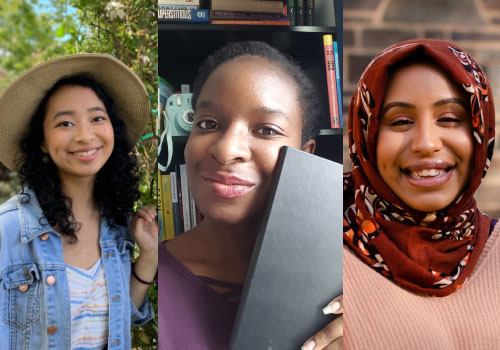
We feel super lucky here at NaNo HQ to be able to work with some excellent interns! Today, meet our newest cohort of interns: Sandra, Chyina, and Fatima. You’ll be getting to know them better throughout November, but today they’re here to tell you a little about themselves:
Hi Wrimos—it’s going to be a weird one this year! I type this introduction from the brick buildings of Providence, Rhode Island, where I remain holed up with my housemates. Our walls are thin enough that we can hear each other as we attend our respective classes; we emerge for sustenance and, occasionally, the craven desire for friendship, which would be typical for college students if it weren’t for the ever-present pandemic looming over our heads.
Last night, I woke up shivering because of an unaccountable cold snap, when it’s usually sweltering in Rhode Island until late September. Meanwhile my family in California wake up to red skies and temperatures well into the 100s. I haven’t felt this unsure about my future since I was eight and learned that someday, the sun would swell into a red giant and vaporize our planet, and in such chaos, I find myself exceedingly grateful for the regular annual event of NaNoWriMo.
This NaNoWriMo, I’m looking forward to seeing all the wonderful ways our community can reach across the web to connect! Already, in the YWP forums I’ve seen so many ways young writers are supporting each other in these times of stress; who’s to say us ancient ones can’t equally rise to the occasion? Right now, the constant in my life is looking for the kinder moments in life, the neighbors helping each other, the small acts of solidarity and compassion in even just a pal reaching out to check on me. I anticipate many of those moments emerging this November, as writer alike helps each other to the finish line.
I said it would be a weird one this year, but weird is good, I’ve found. Weird is memorable—in the long and storied history of NaNoWriMo, this year will truly stand out as a novel-ty (hah). As this year’s Program Intern, I hope this introduction has already told you what you need to know about me: I love this community, and my entire role is devoted to cheering you all on. It’s a selfish wish too—I’ll be alongside the rest of you, trucking along with a garbled mess of a novel, and feeding off the communal energy.
Anyone who undertakes the creative behemoth of NaNoWriMo in these times has already won, in my humble opinion, as creators and authors of tales waiting to be told. Looking forward to the next few months!
Chyina, Editorial InternPicture a young girl reading the complete works of Edgar Allan Poe. Fast forward a few years and she has discovered that the only thing she wants to do is work with words: reading them, writing them, editing them, or making them up. Now, imagine a year of pure chaos and craziness.
You may have guessed that the girl is me and that the year is 2020. Well, as ridiculous as this year has been, it did give me the opportunity to work with NaNoWriMo as an intern. I have been participating since I was in high school and when I found out that they were looking for remote interns for the first time ever, I had to apply. And I cannot wait to begin working as the Editorial Intern this fall.
For the curious minds who may want to know more about who I am, my favorite book is The Book of Disquiet by Fernando Pessoa, a book I discovered when I participated in DisQuiet, an international literary program. It’s a book the author calls his “factless autobiography” and has a timeless quality I aspire to have in my own work. I try to find inspiration in the little things, like the leaf floating through the air or why that one book in your library smells like gasoline.
I also am the cofounder of the Women of Color Writers’ Circle, which is an international group dedicated to showcasing and nurturing the voices of women of color. I haven’t thought of a solid NaNo project yet, but I have dozens of ideas floating in my head.
Thanks for having me! I can’t wait to get started working with all my fellow word nerds.
Fatima, Tech InternHey y’all!
My name is Fatima and I am super excited to be joining this amazing community as your fall tech intern. I am currently a junior at Cornell University majoring in Information Science and Sociology. I am studying remotely from Illinois this year, which means I am always a mess and in fear of missing a meeting. My classes are on Eastern Standard Time, this internship is on Pacific Standard Time, but I am living in Central Standard Time. Time zones are beating me up. (Fun fact: I learned about the existence of Mountain Standard Time at my first NaNoWriMo HQ meeting a few weeks ago)
I am passionate about racial and gender equity in tech and the intersections of the humanities with technology. On campus, I’m trying to start a Digital Humanities club and am involved in many womxn of color organizations. A few personal projects of mine currently are getting my email inbox down to 0 (last week it was 5,035, today it’s 3,454–progress!), finishing the Couch to 5K challenge (I’m on week 5), and finding out who Mary Alice really is on Desperate Housewives.
I say that I’ve been a Wrimo since I was 12, but I’ve only fully participated one year. I’ve tried to do different takes on the challenge like writing in my journal every day (very relaxing, definitely recommend) and writing a short story every day (was really hard to come up with new ideas and sadly I burnt out quickly). I also enjoy watching NaNoWriMo prep videos and vlogs on YouTube, introducing friends to NaNoWriMo, and following writing inspiration accounts on Instagram and Pinterest. I definitely talk about writing and call myself a writer more than I actually write but that will all change this November (hopefully)!
Chris Baty's Blog
- Chris Baty's profile
- 63 followers



